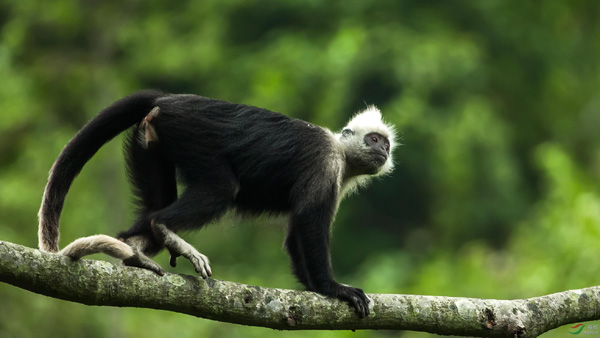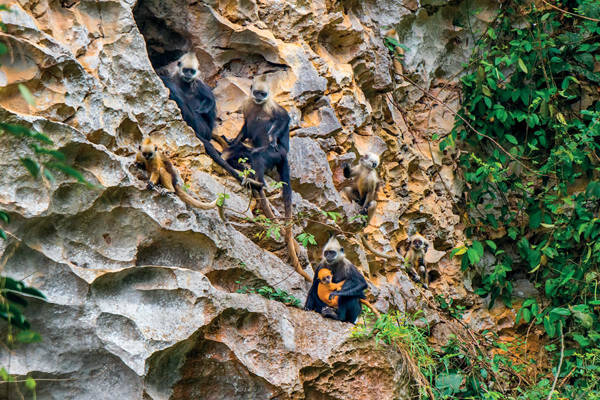Trachypithecus poliocephalus
IUCN
LCBasic Information
Scientific classification
- name:Trachypithecus poliocephalus
- Scientific Name:White-headed langur
- Outline:Primates
- Family:Primates Cercopithecidae Trachypithecus
Vital signs
- length:47-63cm
- Weight:6.7-15kg
- lifetime:25year
Feature
One of the rarest primates in the world, and possibly the rarest in Asia, with a population estimated at less than 70 individuals.
Distribution and Habitat
White-headed langurs are only distributed in a very narrow triangular area between Zuojiang and Mingjiang in Guangxi in China, with an area of less than 200 square kilometers. The specific locations include Shangjin Township in Longzhou County, Guangxi, Tingliang and Tuolong Township in Ningming County, Luobai Township, Banli Township, Shutuan Town, and Tuolu Town in Chongzuo City; and parts of the five townships of Bapen, Shanwei, Qujiu, Quli, and Dongmen in Fusui County.
The habitat of white-headed langurs is located in the subtropical karst area with lush vegetation in southern Guangxi, China. It has a typical karst terrain, with continuous stone mountains, steep peaks, cliffs, and karst caves everywhere, providing a good natural environment for its survival and reproduction.
Appearance
The white-headed langur and the black langur are similar in shape and size, with a small head, a thin body, slender limbs, and a tail longer than the body. Its body hair is also mainly black, but unlike the black langur, it has a tuft of upright white hair on its head, shaped like a pointed white melon-shaped hat, white neck and two shoulders, black upper half of the tail, white lower half, and some white on the back of the hands and feet.
White-headed langurs mainly mate in autumn and give birth in spring. The white-headed langur cubs are very beautiful, with golden hair all over their bodies. As the golden cubs grow up, the middle part of their bodies slowly turn gray, and finally they become like their parents.
As the name suggests, the white-headed langur is called a langur, because it eats leaves and feeds on young leaves and branches of plants. 80%-90% of its food is leaves. In its environment, in the environment where it lives, there are all kinds of leaves. It likes to ea
Details
The white-headed langur is named for its food of leaves and is a rare monkey in my country.

The white-headed langur is alert, very lively, active, and very good at jumping. The slender body, slender limbs, and well-developed hip calluses are just adapted to the life of living in trees and rocks. They can jump freely in the woods or on steep cliffs, and walk like flying. The long tail plays an excellent balancing role.
White-headed langurs like to live in groups, and the group is not large. A small group may have five or six, and a large group may have more than ten, and rarely more than twenty. The size of the group is related to the leadership ability of the monkey king. If a monkey king has weak leadership ability, then when the group grows larger, some monkeys will run away and form a new group, and the monkey group will be smaller. In this group society, there is only one adult male monkey, the monkey king, and the others are some adult female monkeys. This is a polygamous society. Then there are some underage monkeys in this monkey group, and these underage monkeys are both female and male. When these monkeys grow to be sexually mature at the age of three or four, the female monkeys still stay in the monkey group and reproduce with their mothers and other aunts. When the male monkeys are close to sexual maturity, they leave their birth group and go to other monkey groups to be kings. This process requires fighting. If the new male monkey wins, then he can go to another monkey group to be the king. If he can't win, he will continue to form a temporary group with several male monkeys. After the new monkey king takes office, a very cruel situation will appear, that is, infanticide. This makes the female monkey who originally had a baby monkey mate and reproduce with it as soon as possible to reproduce its own offspring.
China has conducted multi-faceted research and protection work on the rare species of white-headed langurs, striving to prevent them from extinction. In the early 1980s, there were only about 80 white-headed langurs left in Guangxi's Baben Nature Reserve and Banli Nature Reserve. At that time, all the white-headed langurs in Guangxi were estimated to be more than 200, which was already in an extremely endangered state. After continuous efforts from many aspects, the total number of white-headed langurs has reached about 800. As of February 2022, the population of white-headed langurs has increased from about 500 in the early years to more than 1,300.
It is listed as a first-class protected animal in China's "National Key Protected Wildlife List" and as an endangered species in the "China Red Book of Endangered Animals".
Listed in the "Red List of Endangered Species of the World Conservation Union" (IUCN) 2015 ver 3.1-Critically Endangered (CR).
Listed as a Class I protected animal in the Washington Convention CITES.
Listed as a Class I protected animal in China's National List of Key Protected Wildlife (February 5, 2021).
Protect wildlife and eliminate game.
Maintaining ecological balance is everyone's responsibility!











